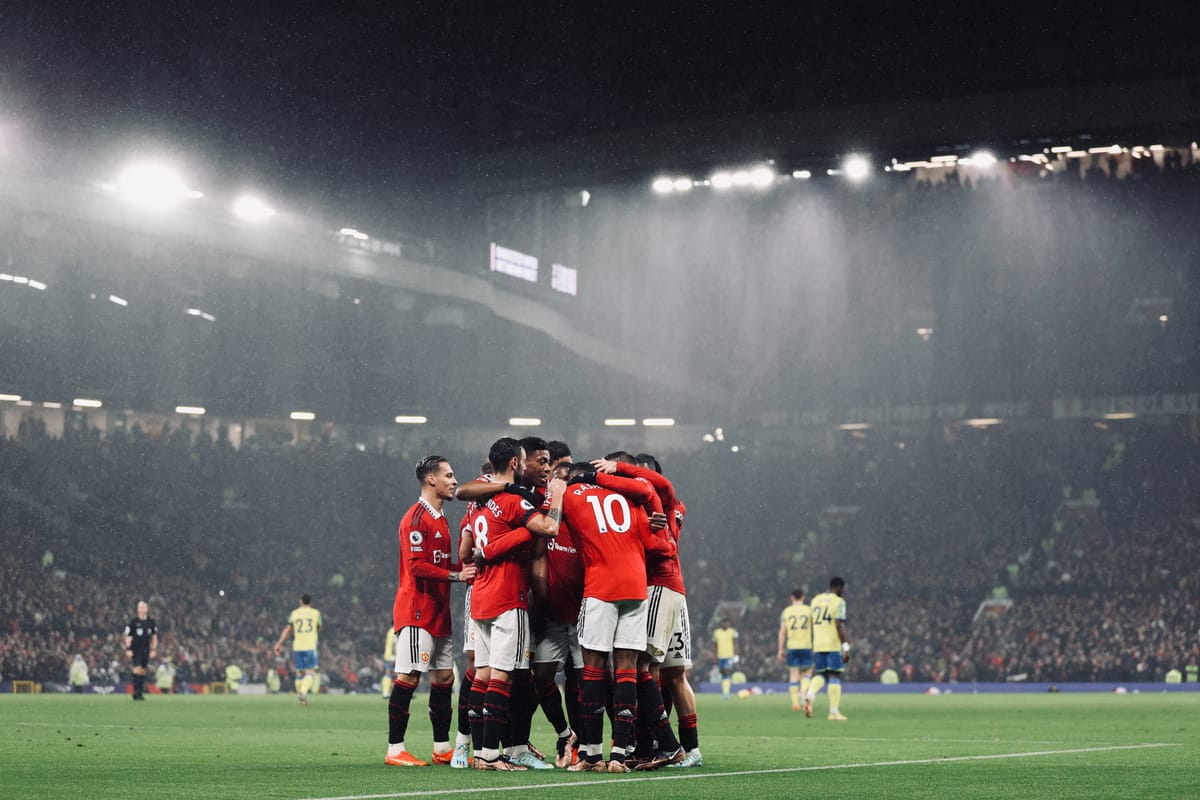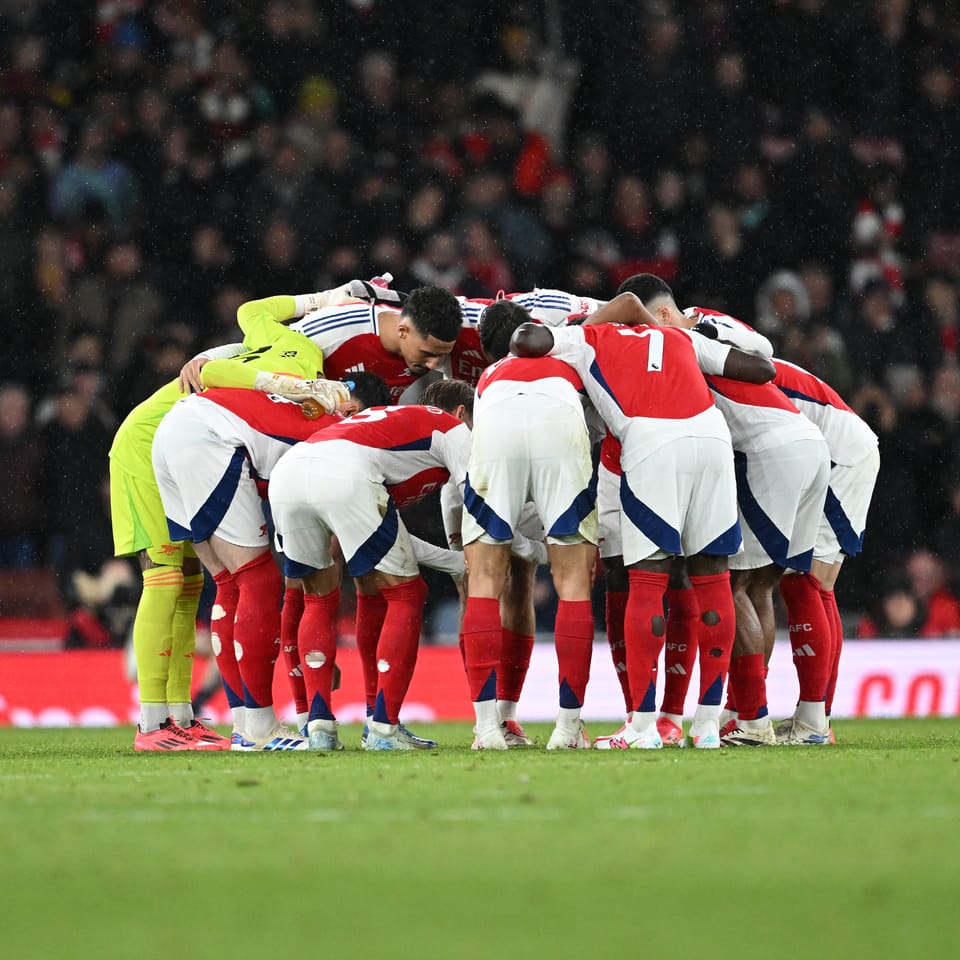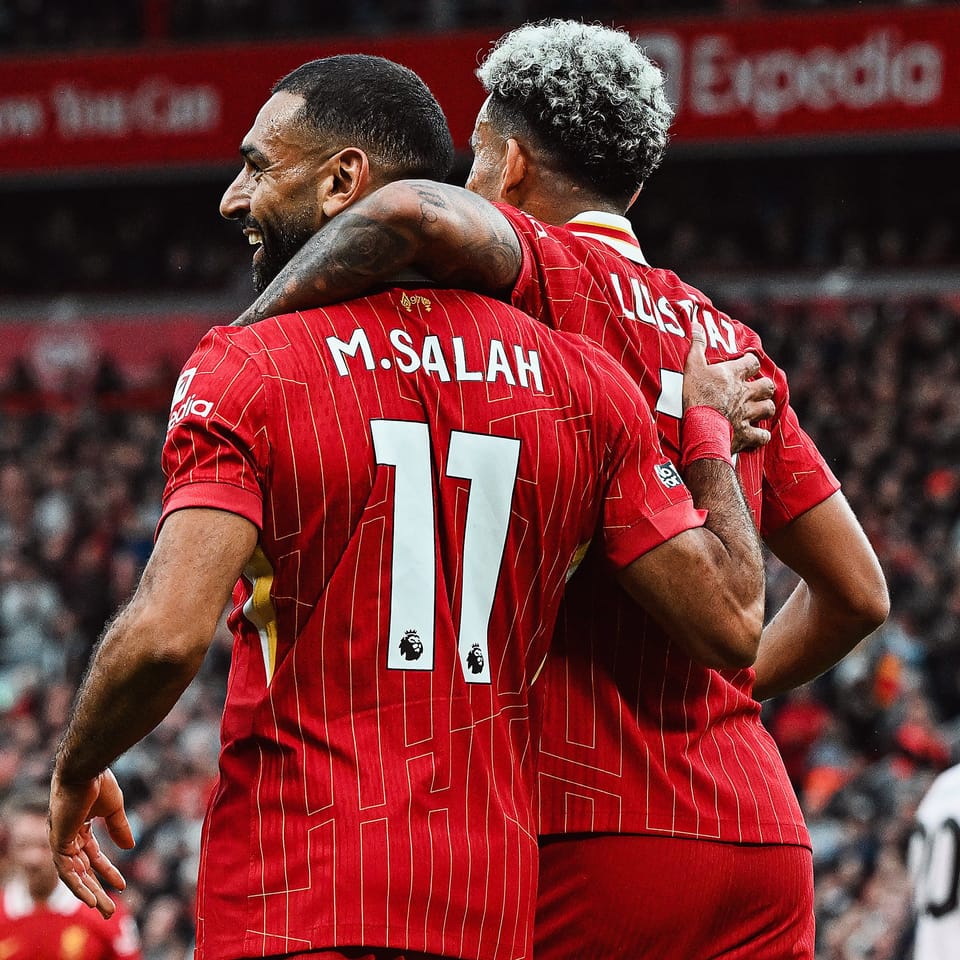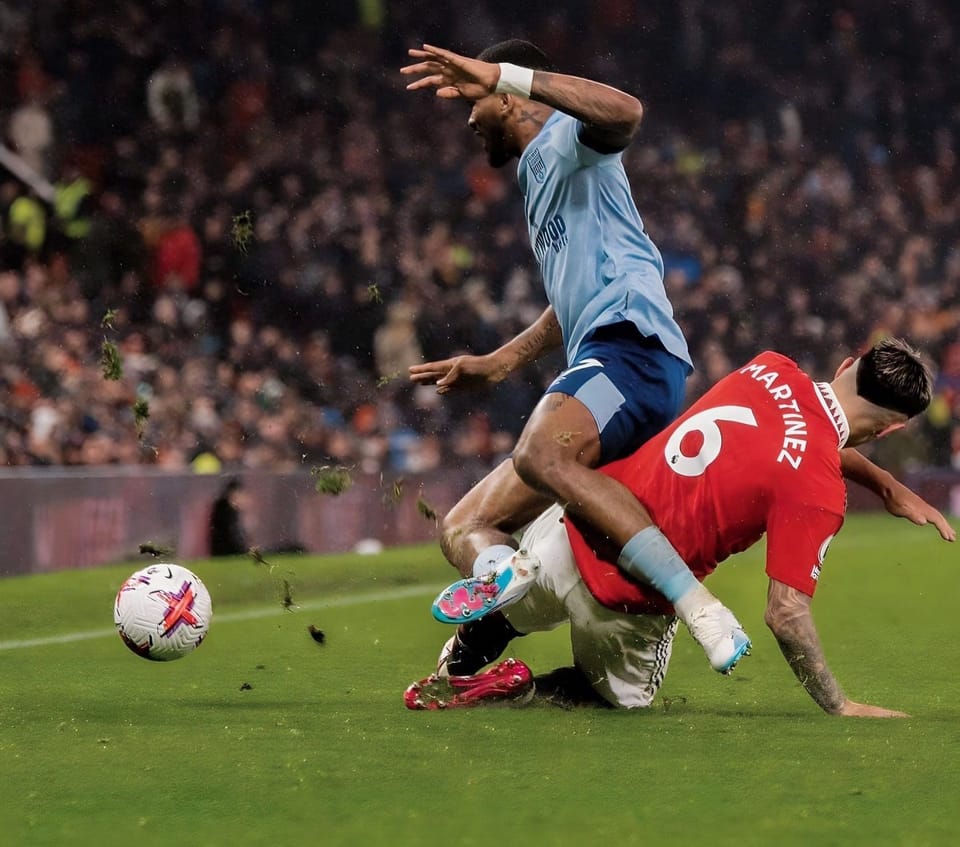The Tweaks Behind Manchester United’s Resurgence

The highlight of United’s crucial wins over the past three game-week has been De Gea booting the ball long. After the Brentford defeat, where United got caught out playing from the back, some caution has been employed in the team’s tendencies while the ball is in their defensive third.
In this article, I will attempt to unpack the dilemma.
PLAYING OUT OF THE BACK (C’EST QUOI?)
First, let us briefly understand what it means to play out from the back.
Playing out from the back is an in-possession principle whereby teams initiate possession sequences from their defensive third–usually with short passes–rather than clear it long and contest for second balls. There are a few reasons why teams do this. A couple of reasons–the ones most relevant for the discourse today are:
- To maintain control of the ball by limiting the long balls and second ball instances
- To create artificial transitions after luring the opponent
Maintaining Control
In my last piece, I already explained how despite personnel and structural adaptation to contain them, winning second balls remains one of the more unpredictable aspects of the modern game. To maintain control of the ball, some teams will always choose to play short, where they can more likely control the following action, rather than play a long ball and risk not winning the second ball.
Artificial Transitions
In his piece, “Minimum Width, Maximal Width, or Both”, Jamie Scott writes:
Furthermore, a scenario where the settled possession phase and attacking transition phase can be merged, is when a team generates artificial transitions. This is a situation where a team in settled possession creates a transition-like state, by inducing the opposition to lose their settled defensive structure.
Essentially, artificial transitions are created when a team typically baits the opposition press while playing out from the back, then breaking the lines (by carrying the ball through the lines, sending a long ball over the press, or patiently passing through it) to create a counter-attack situation.
Here is an example of what that looks like.

Ten Hag had his Ajax side play out from the back. However, he is flexible about how this is accomplished.
After the Brentford defeat, he noted similar elements as criticism for his side. When asked about a supposed insistence on playing out from the back, he said:
“I don’t want to play out from the back when it is not possible. It is naive how we played today. It was [expected] that we play more direct after we attracted them. There was space high on the pitch and he had that option [free man]. And that is what we didn’t do.”-Erik ten Hag
Indeed, his side made several turnovers on the ball and conceded an absurd amount of shots in their defensive third. Here is a visualisation from the ever-reliable Markrstats bot (@markstatsbot on Twitter).

Let’s look at the specific instance Ten-Hag was talking asked about in his press conference.
As you can see in the frame, Brentford is fully committed to its man-to-man marking system. Once David De Gea receives the ball from Lisandro, the only viable, unmarked option is the RCB–who is about to be in the cover shadow (albeit poorly executed) of Ivan Toney.

Given Erik Ten Hag’s comments after the game, it seems he’d rather have had the team go long and behind the opposition’s backline. The presence of the full-backs deeper means that there is space on both sides for Rashford and Sancho to receive. That would have been the ideal option based on Ten-Hag’s comments after the game.
Nevertheless, another issue here is De Gea’s body shape when he receives the ball.

The Spaniard neither allows the ball roll across him sufficiently nor take a positive touch to reset. Consequently, he finds himself in a closed stance, the ball is too close to him to generate enough contact, and the angle and range he can play through are limited. These reasons these make the ball to Christian Eriksen easy to read.

The way Ten Hag utilised Eriksen in this game is reminiscent of his deployment of Frankie De Jong during his last season at the club–as the deepest midfielder and primary recipient during the build-up. The dutch midfielder garnered notoriety for single-handedly rupturing the opposition’s defensive structures during his stint at Ajax. It is safe to assume that Ten Hag would have liked to reunite with him for similar reasons.
Kees van Hemmen wrote a very detailed piece,”Frenkie de Jong, Ajax, and Artificial Transitions: Reverse Engineering Insights on Turnovers” on Frenkie’s unique role and ability to creating artificial transitions from a similar position that Eriksen received from.
Unfortunately, Eriksen is no Frenkie de Jong. While he might have the problem-solving and composure in deeper midfield, he lacks the acceleration and ball carrying ability to be able to flip situations like the one above, into situations like attacking ones.
United went ahead and recruited Casemiro for the defensive midfield role, so some of the build-up dynamics, squad compositions, and roles I had observed and analysed during pre-season have now changed.
ALTERATIONS TO UNITED’S APPROACH TO BUILD-UP
Well, Brighton and Brentford happened. United could not play out from the back effectively during those first two games of the season.
In the subsequent matches, United reverted to a longer, more direct style from the back–ditching the previous attempts to play out from the back. They also started utilizing second balls to progress the ball–which is ironic given that Brighton and Brentford had employed similar approaches to exploit their frail defence and larger structural mishaps.

There has been a significant increase in the number of long balls David De Gea has attempted in the most recent games, indicating an alteration in build-up tendencies for Ten Hag’s side.
Here is a visualisation from the Leicester match showing a preference:

The most important thing to note in this visualisation is the concentration of progressive pass attempts–especially from deep–to wide areas. We shall investigate to understand how and why this tactical decision was made with some segments from the Leicester game.
Situation One
In some moments, the decision to play long adhered, and the accompanying rotations were coherent. The central players held their positions–rather than aggressively show/adjust for the ball as you’d expect if they were playing out from the back–and the fullbacks pushed forward to create wide overloads, assist with the second balls, and offer themselves as outlets.
In my last piece, I highlighted this kind of long ball as a chosen ball–situations where a player deliberately ‘choses’ to play a long ball while is in play despite them having time and space.

The full backs are out of frame here and positioned much higher to engage with the the second ball. United have fewer players in their defensive third and have prioritized higher occupation.

Situation Two
However, in other instances in the second half, while United was trying to preserve the lead, there was confusion in the backline about which kind of pass should be played. As a result, United lost some coverage for their second balls.

Dalot and McTominay race towards the ball to provide an option for De Gea to play out from the back, but the Spaniard has already pre-determined to launch the ball.
The consequence is then that United lose compactness in the middle of the pitch and are susceptible to getting countered.

In this instance, De Gea opts to clear the ball to the right wing–where Dalot had just vacated–and Elanga tries to track back but loses the duel.
Situation Three
De Gea received an unpressurised back-pass from Casemiro and United are 3v1 on the first line vs Jamie Vardy. Casemiro motioned for the him to calm down and retain possession, but the Spaniard goes ahead and clears it long.

United were actually in a comfortable position to play out from the back, but De Gea is unable to discern the situation and game-state and launches the ball long.
United are actually decently set up to contest for the second-ball, but such is the nature and unpredictability of those moments, that United end up like.


WHAT DOES THIS MEAN FOR TEN HAG’S INITIAL TACTICAL SCHEMES?
These recent changes have been influenced by a failure to conclude recruitment early, a poor start to the season, and consequently, an altered recruitment strategy.
Casemiro has been signed. Consequently, some of the structures in the first two phases (build-up and progression) from pre-season and the first two games of the season–which were seemingly built with the intention of housing De Jong–will be markedly different. I already highlighted one of these: directness from the back.
To understand the other differences that may arise, let’s compare the squad composition and roles after the first two games of the season and Casemiro becoming the marquee midfield signing.

United trialled with a 4-3-3 (nominally)–with Fred as the deepest midfielder–in possession during pre-season and the first couple games of the season.
Here is how that looked in pre-season (find the piece with more details here):

However, it now seems as though Ten-Hag will deploy a 4-2-3-1 formation in possession with a distinct attacking midfielder–at least in the build up phases.
Here is a segment from the Leicester game showing a common rotation that will occur with this shape.

This 2nd phase shape is once which Ten Hag has deployed before–an instance being his 2021/2022 Ajax side with Edson Alvarez (now McTominay, and eventually Casemiro) in the pivot role.
Here’s an instance of that shape in an Ajax match vs Valencia in the Champions League:

If you would like to read more about this shape, here is the link to the article by Chaka Simbeye (Twitter @chaka_simbeye).
Pioneering this change is Casemiro: the Brazilian will likely be deployed as a transition diffuser in the pivot–tasked with breaking up plays and making first contact with aerials. These are facets of his game that are particularly prominent as shown in this profile by Andy Forrester (@AndyForrester1 on Twitter):

Notice that Casemiro is not overtly inclined to progress the ball (a tendency rather than an inability). Consequently, the responsibility will fall more on the full-backs and center-backs to offer guile and progression for the side.
In order to achieve this, we might see a 3-2-5 build up shape (with one of the FB tucked in to form a back-three) while the ball is in the second phase.
In the final third, there will likely be few, if any, changes to the attacking and chance-creation dynamics (someone should write about this).
Do these altered dynamics make United a stronger team than otherwise? We may never know but there is a lot–analyses-wise–to look forward to as the side adapts to Ten Hag’s adjusted tactical set-up.
What Next?
If you enjoyed this, consider subscribing to BallerzBantz, following us on Twitter, and sharing this with someone.
Join us to stay ahead and contribute to this burgeoning community.
Who is the Writer?
Joel A. Adejola is an undergraduate at the University of Kansas (KU), studying Engineering and Philosophy.



